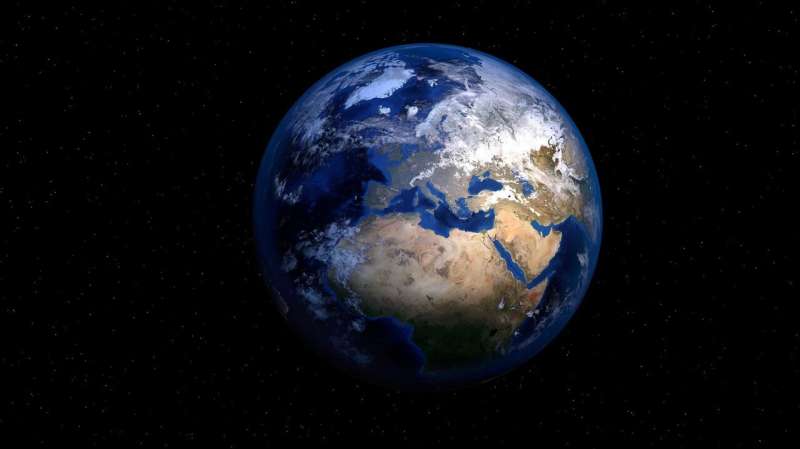Exceeding functional biosphere integrity limits: Study finds 60% of the world's land area is in a precarious state

Sadie Harley
scientific editor

Robert Egan
associate editor

A new study maps the planetary boundary of "functional biosphere integrity" in spatial detail and over centuries. It finds that 60% of global land areas are now already outside the locally defined safe zone, and 38% are even in the high-risk zone.
The study was led by the Potsdam Institute for Climate Impact Research (PIK) together with BOKU University in Vienna and in the journal One Earth.
Functional biosphere integrity refers to the plant world's ability to co-regulate the state of the Earth system. This requires that the plant world is able to acquire enough energy through photosynthesis to maintain the material flows of carbon, water and nitrogen that support the ecosystems and their many networked processes, despite today's massive human interference.
Together with biodiversity loss and climate change, functional integrity forms the core of the analytical framework for a safe operating space for humanity.
"There is an enormous need for civilization to utilize the biosphere—for food, raw materials and, in future, also for climate protection," says Fabian Stenzel, lead author of the study and member of the PIK research group Terrestrial Safe Operating Space.
"After all, human demand for biomass continues to grow—and on top of that, the cultivation of fast-growing grasses or trees for producing bioenergy with carbon capture and storage is considered by many to be an important supporting strategy for stabilizing climate.
"It is therefore becoming even more important to quantify the strain we're already putting on the biosphere—in a regionally differentiated manner and over time—to identify overloads. Our research is paving the way for this."
Two indicators to measure the strain and the risk
The study builds on the latest update of the Planetary Boundaries framework published in 2023.
"The framework now squarely puts energy flows from photosynthesis in the world's vegetation at the center of those processes that co-regulate planetary stability," explains Wolfgang Lucht, head of PIK's Earth System Analysis department and coordinator of the study.
"These energy flows drive all of life—but humans are now diverting a sizable fraction of them to their own purposes, disturbing nature's dynamic processes."
The stress this causes in the Earth system can be measured by the proportion of natural biomass productivity that humanity channels into its own uses—through harvested crops, residues and timber—but also the reduction in photosynthetic activity caused by land cultivation and sealing.
The study added to this measure a second powerful indicator of biosphere integrity: An indicator of risk of ecosystem destabilization records complex structural changes in vegetation and in the biosphere's water, carbon and nitrogen balances.
Europe, Asia and North America particularly affected
Based on the global biosphere model LPJmL, which simulates water, carbon and nitrogen flows on a daily basis at a resolution of half a degree of longitude/latitude, the study provides a detailed inventory for each individual year since 1600, based on changes in climate and human land use.
The research team not only computed, mapped and compared the two indicators for functional integrity of the biosphere, but also evaluated them by conducting a mathematical comparison with other measures from the literature for which "critical thresholds" are known.
This resulted in each area being assigned a status based on local tolerance limits of ecosystem change: Safe Operating Space, Zone of Increasing Risk or High Risk Zone.
The model calculation shows that worrying developments began as early as 1600 in the mid-latitudes. By 1900, the proportion of global land area where ecosystem changes went beyond the locally defined safe zone, or were even in the high-risk zone, was 37% and 14% respectively, compared to the 60% and 38% we see today.
Industrialization was beginning to take its toll; land use affected the state of the Earth system much earlier than climate warming. At present, this biosphere boundary has been transgressed on almost all land surface—primarily in Europe, Asia and North America—that underwent strong land cover conversion, mainly due to agriculture.
"This first world map showing the overshoot of the boundary for functional integrity of the biosphere, depicting both human appropriation of biomass and ecological disruption, is a breakthrough from a scientific perspective, offering a better overall understanding of planetary boundaries," says Johan Rockström, PIK Director and one of the co-authors of the study.
"It also provides an important impetus for the further development of international climate policy. This is because it points to the link between biomass and natural carbon sinks, and how they can contribute to mitigating climate change. Governments must treat it as a single overarching issue: comprehensive biosphere protection together with strong climate action."
More information: Breaching planetary boundaries: Over half of global land area suffers critical losses in functional biosphere integrity, One Earth (2025). .
Journal information: One Earth
Provided by Potsdam Institute for Climate Impact Research



















